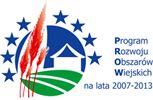B -11 c bicycle trail – red markings – “Podlachian Stork Trail”
Janów – Korycin bicycle trail (24km)
Janów – Korycin bicycle trail, marked green, leads along local roads that run not far from Kumiałka river. While travelling by bike, we will observe not only the beautiful valleys of Kumiałka, but also an interesting lie of the land – Szomowskie hills. Another attractions of the trail are medieval fortified settlements in villages of Aulakowszczyzna and Milewszczyczna, water mills in Sitawka, Romaszówka and Rudka.
The trail is 24km long, an ideal length for Sunday family bicycle trips.
0,0 km JANÓW – village, formerly a town city, seating for the commune administration office. Located by the Kumiałka river and Korycie – Sokółka road. First settled at the turn of 17th and 18th century. Old name – Przybudek /could be translated as “next to the huts”; name derived from tar makers’ huts in the forest/.The name Janów was first noted in 1715. It received municipal charter in 1791 and lost it at the end of 19th century. The town was developing in 18th and 19th century /activities of court treasurer A. Tyzenhauz/, headquarters of a demesne, a few workshops. Janów is currently a centre of folk weaving – two-warp carpets, a tourism trail “following the tracks of folk craftsmanship” goes through the village. Romanesque revival St. George church of 1904. In Communal Community Centre – a school of folk weaving. The trail starts by the coach stop. From the square in front of the church we take a right turn into ul. Białostocka street. We go forward in the direction of the cemetery passing by the Communal Community Centre and a school on the right. After passing by the cemetery, we take a left turn. We go along the road to Sitawka watermill.
2,0 km SITAWKA WATERMILL – a mill from the interwar period, build over the Kumiałka river. Operational and currently in use. An artificial water reservoir is to be built here, serving as a place for leisure and recreation for locals.
Going the unpaved road north we are returning to Janów. After turning left, we ride further in the direction of the village centre, then pass the church from the north. We turn right and take the Janów – Korycie asphalt road until the crossing with a road going to Jasionowa Dolina. Before the crossing, we have passed “Panderosa” Club – the capital of disco-polo music.
7,5km JASIONOWA DOLINA – village founded in 17th /18th century during the colonisation of Kuźnicka Forest. There are several burial mounds from 5th-6th century by the main village road and an interesting wooden cross next to the shrine.
After reaching the place, we turn left into the main road going through the entire village. That road will lead us to the bridge on the Kumiałka river. After passing the bridge, we take an unpaved road going northwest. On the left hand there will be the meandering river. This way we will reach the village of Wyłudź.
9,5km WYŁUDKI – We use the cobbled road to continue going west and, after 1km, reach the Wyłódź village.
10,5km WYŁUDY- a village founded in 17th century, during the colonisation of Kuźnicka Forest. The name most probably derives from “Wyłuda” – first or last name of a settler. In the interwar period Wyłudy and Wyłudki were considered a rich villages, of efficient agriculture.
In the middle of the village we take a left turn and, after going south for 2,5km, we reach to the asphalt road between Korycie and Janów.
12,5km ZABRODZIE – village founded in 17th century, by the Janów-Korycie road. Former crown land. A few votive crosses in the village, also architecturally interesting school building from 1930s resembling a Polish nobleman’s manor. Coach stop.
We turn left and use the paved road. After 500 meters, we get to Romaszówka Kolonia.
ROMASZKÓWKA – it is a few farms standing close to a working, electric mill. River fork is an evidence that there was a water mill here in the past.
The trail leaves the paved road and goes right, into a gravel road going south. We use it to get to an edge of a young forest, where we turn left /walking trail leads straight on/. We reach the north edge of the Szumowo village.
15,5km SZUMOWO – a village founded in the early 17th century in former Kuźnicka Forest, on the crown land. Name of the village derives from name of a settler – Szuma. There is a few wooden and metal votive crosses in the village. East of it, an interesting landscape of Szumowo Hills.
While in the village, we go along the cobbled road until we reach the last buildings. Here we turn right and then left and reunite with the walking trail. Using an unpaved road, we ride southwards to the edge of Aulakowszczyzna village.
17,5km AULAKOWSZCZYZNA – village founded in early 17th century, former crown land from Kumialski demesne. Well preserved medieval fortified settlement, with visible bulwark and area around the fortifications.
We leave the unpaved road turning right into an asphalt road, which will lead us to Gorszczyzna Coach Stop.
18,5km GORSZCZYZNA – – another small village by the Kumialka river founded in 17th century.
We don’t enter the village but pass it from the left. We continue to ride the same road. On the crossroads in Milewszczyzna village, we turn right. After passing the bridge on Kumiałka river, we once again reunite with the walking trail.
19,5km MILEWSZCZYZNA – a village from 17th century, there was a water mill here in the past. A medieval fortified settlement on top of which now-abandoned farms were build. Good camping spot.
A gravel road going north will take us to the crossing on which we turn left and, after approx. 300m, we turn left again into a back road leading to Rudka village
22,0km RUDKA – 17th century village by the Kumialka river. The name derives from bog iron (‘ruda’ means ‘ore’) that can be found on nearby meadows in small quantities. The most interesting building in the village is a wooden water mill located on the old dyke. The mill is currently a tourism facility /accommodation for tourists/.
From the mill, we go southwards to the paved road and there turn right in the direction of now visible church in Korycin. Opposite the cemetery we turn right into a path leading through the old Plebański Park from 17th century. We pass the church from the right and get to Korycin.
24,0km KORYCIN – village and administration centre of the commune, founded in 17th century as a ranger village guarding the Kuźnicka Forest. Original name was Dąbrówka-Kumiałka. Contemporary name derives from bark roofing (‘kora’ means ‘bark’), or, more probably, from location by the Kumialka river bed (‘koryto rzeki’ means ‘bed of the river’). Magdeburg town privileges gained in 1671, lost at the end of 19th century. Urban arrangement from 17th century preserved to this day. Gothic revival Feast and Parish of the True Cross church built in 1905, located on the hill, is visible from any direction within range of few kilometres. Behind the presbytery there is a park from 18th century. In the centre of the village there is a square with two monuments, one with Korycin’s crest, other dedicated to anniversary of regaining independence by Poland after the period of Partitions.
We enter the Korycin square. The trail ends here.













